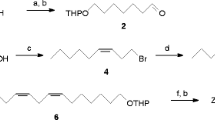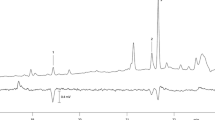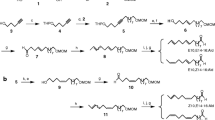Abstract
The sex pheromone of the citrus fruit borer Ecdytolopha aurantiana has been identified by gas chromatography coupled to an electroantennographic detector (GC-EAD). The electron impact mass spectral (EI-MS) fragmentation of the major EAD-active peak gave identifying features for a monounsaturated acetate. Further analyses by chemical ionization mass spectrometry (CI-MS), vapor-phase infrared spectroscopy (GC-IR), along with chemical derivatization (DMDS reaction), led to full characterization of the major component as (E)-8-dodecenyl acetate (E8–12 : Ac). The second constituent was identified as the related alcohol, (E)-8-dodecenol (E8–12 : OH). The two compounds were indistinguishable from the authentic synthetic standards in chemical and EAD analyses. Samples of the two compounds were obtained by a facile synthesis utilizing lithium chemistry. Field tests showed that captures in traps baited with a mixture of E8–12 : Ac and E8–12 : OH at 100 : 1 and 10 : 1 ratios were not significantly different from the catches in traps having two virgin females. Dosage tests showed better performance of traps baited with 1 mg than those with 0.1 mg of the pheromone blend, either in 100 : 1 or 10 : 1 ratio.
Similar content being viewed by others
REFERENCES
ANDO, T., YOSHIDA, S., TATSUKI, S., and TAKAHASHI, N. 1977. Sex attractants for male Lepidoptera. Agric. Biol. Chem. 41:1485-1492.
ANONYMOUS. 2000. Tecnologia contra o bicho-furãao. Revi. Fundecitrus 96:8-10.
ARN, H. 1991. Sex pheromones, pp. 187-207, in L. P. S. Van der Geest and H. H. Evenhuis (eds.). World Crop Pests, 5. Tortricid Pests: Their Biology, Natural Enemies and Control. Elsevier, Tokyo.
ARN, H., TOTH, M., and PRIESNER, E. 1998. http://www.nysaes.cornell.edu/pheronet/
ATTYGALLE, A. B. 1998. Microchemical techniques, pp. 207-294, in J. G. Millar and K. F. Haynes (eds.). Methods in Chemical Ecology: Chemical Methods, Vol. 1. Kluwer Academic Press, New York.
BENTO, J. M. S., PARRA, J. R. P., VILELA, E. F., WALDER, J. M., and LEAL, W. S. 2001. Sexual behavior and diel activity of citrus fruit borer Ecdytolopha aurantiana (Lepidoptera: Tortricidae). J. Chem. Ecol. 27:2053-2065.
LEAL, W. S. 1998. Infrared and ultraviolet techniques, pp. 185-206, in J. G. Millar and K. F. Haynes (eds.). Methods in Chemical Ecology: Chemical Methods, Vol. 1. Kluwer Academic Press, New York.
LEAL, W. S., HASEGAWA, M., MOCHIZUKI, F., and YASUDA, T. 1992. Behavioral and electrophysiological evidence of sex pheromone(s) in Anomala schonfeldti Ohaus (Coleoptera: Scarabeidae). Appl. Entomol. Zool. 27:592-594.
ROELOFS, W. L. and BROWN, R. L. 1982. Pheromones and evolutionary relatioships of Tortricidae. Annu. Rev. Ecol. System. 13:395-422.
SNEDECOR, G. W. and COCHRAN, W. G. 1989. Statistical Methods, 8th ed. Iowa University Press, Ames, Iowa.
STRUBLE, D. L. and ARN, H. 1984. Combined gas chromatography and electroantennogram recording of insect olfactory responses, pp. 161-178, in H. E. Hummel and T. A. Miller (eds.). Techniques in Pheromone Research. Springer-Verlag, New York.
Author information
Authors and Affiliations
Rights and permissions
About this article
Cite this article
Leal, W.S., Bento, J.M.S., Murata, Y. et al. Identification, Synthesis, and Field Evaluation of the Sex Pheromone of the Citrus Fruit Borer Ecdytolopha aurantiana. J Chem Ecol 27, 2041–2051 (2001). https://doi.org/10.1023/A:1012242904220
Issue Date:
DOI: https://doi.org/10.1023/A:1012242904220




